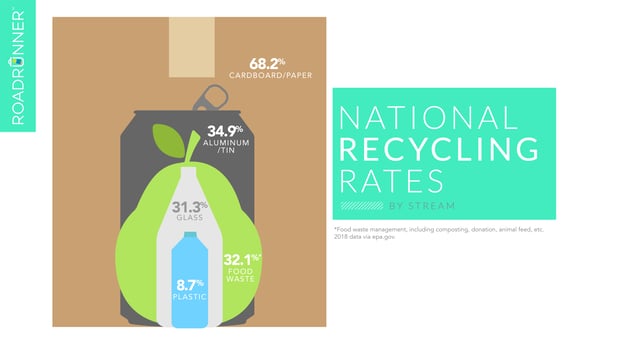When spring finally arrives, all of the things occupying the back of a warehouse, back of a refrigerator, and back of the mind come back into focus.
To the untrained eye, it’s junk — material you’ve put off removing or completely forgotten about. And now that you realize it, you know it belongs anywhere but there.
While Americans have shown a strong desire to recycle — over 90% support recycling efforts — it’s not usually the first action that comes to mind when clearing out something unwanted.
That’s why, outside of loss caused by contamination and operational inefficiencies, our “throwaway culture” is to blame for poor national recycling rates.
But know this: Not all junk is trash.
Reflexively, during spring cleaning or not, businesses send valuable, reusable materials like paper, cardboard, plastic, and glass to landfill. But if these companies, and the individuals within them, saw the positive impact on their supply chain, their waste bill, and the environment, they might rethink how they tidy up.
Room for Improvement
Overall, the EPA’s latest data reflects a 32.1% national recycling rate, yet that doesn’t paint the whole picture. Breaking it into streams, however, can highlight where we have room for improvement.
Put plainly, they're low. And if forfeiting 65% and higher of the country's "seventh" resource inspires you to take action, it'll help to know what to look for...
Know Before You Throw
The adage goes “one man’s trash is another man’s treasure.” However, if it’s recycling, there’s a good chance it’s an entire country’s treasure.
Globally, we’re concurrently facing an aluminum shortage, a cardboard shortage, and a glass shortage, all driven by COVID-19 pandemic disruptions and skyrocketing demand for containers and packaging.
A general rule of economics, when demand outstrips supply (in this case, by a considerable amount), prices go skyward. From producers to consumers, supply chain slowdowns and 3x markup, everyone feels the brunt of a lack of materials.
It would interest everyone, then, to know the following: Clean cardboard can be recycled five to seven times before degrading in quality, while aluminum and glass can be endlessly recycled, forever.
Plastic, as ubiquitous and cheap to produce as it is, might also encounter a reckoning in the coming years. As EPR laws and sustainability mandates find traction, producers will be required to manufacture new products above a certain threshold using recycled plastics.
That’s why, as you clear out offices, factories, restaurants, and your own home in the name of spring cleaning, you need to recognize 1.) that the materials that you often throw away can save you in the long run, 2.) injecting them back into a circular economy benefits everyone.
All of the following are recyclable materials you should keep out of the trash:
![]()
Newspaper: Kept clean and dry, newspaper is a candidate for a closed loop, meaning it can return as newspaper again. Stack newspaper in your bin or dumpster with other paper products, but don’t bind or bag them with plastic. Bonus: Because many newspaper publishers use soy-based ink, newspaper is also compostable (double-win!).
Magazines: Most magazines are recyclable despite their glossy appearance. Remove any preservative plastic packaging and address labels—as they’re likely pressure-sensitive adhesives (PSAs) that resist the pulping process. However, you do not need to remove staples!
“Junk Mail:” Provided the envelope doesn’t have a plastic window, everything about a standard piece of mail is recyclable provided it’s clean and dry.
Manila folders: Unwanted cardstock folders can be collected and placed in the recyclables. However, if folders are the “hanging” variety found in filing cabinets, aluminum sliders and plastic label tags must be removed.
Paperback books: Paperback books like novels and phone books can be recycled like other paper products. Hardcovers are not accepted.
Mixed paper: From misprints to old memos to the pink slip of a handwritten invoice, all of this paper can be recycled. Removing all staples and paperclips isn’t necessary.
![]()
Candle jars: After wax and residue is removed, glass candle jars can be placed in your recycling container. A tip for removing wax: freeze candle jars overnight—the wax becomes brittle and is easily pried away from the glass.
![]()
Empty aerosol cans: Provided cans like spray paint, cooking oil, and air freshener are 100% depleted, most haulers accept these steel, mixed metal, and aluminum cans. Remove, and toss, plastic caps.
![]()
Rigid plastic: Rigid plastic products stamped with “chasing arrows” symbol #1 (PETE) and #2 (HDPE) are widely accepted, often found on single-use food packaging and sturdy containers like coffee tubs, detergent, and milk jugs. For unmarked items or #3–7, refer to our guide.
![]()
Food waste: Expired food, forgotten leftovers, and food scraps from restaurants can all be disposed of responsibly. Get in touch with RoadRunner to learn about our workplace composting program.
This list may not be exhaustive of every item you’ll encounter during your cleanout, but knowing the most common trashed recyclables from your business will help you to think—and act—sustainably long beyond the spring season.
For custom solutions to your unexpected discoveries and everyday “junk,” allow us to help. RoadRunner Recycling works with businesses to recycle, on average, 8.6 tons more per year.

